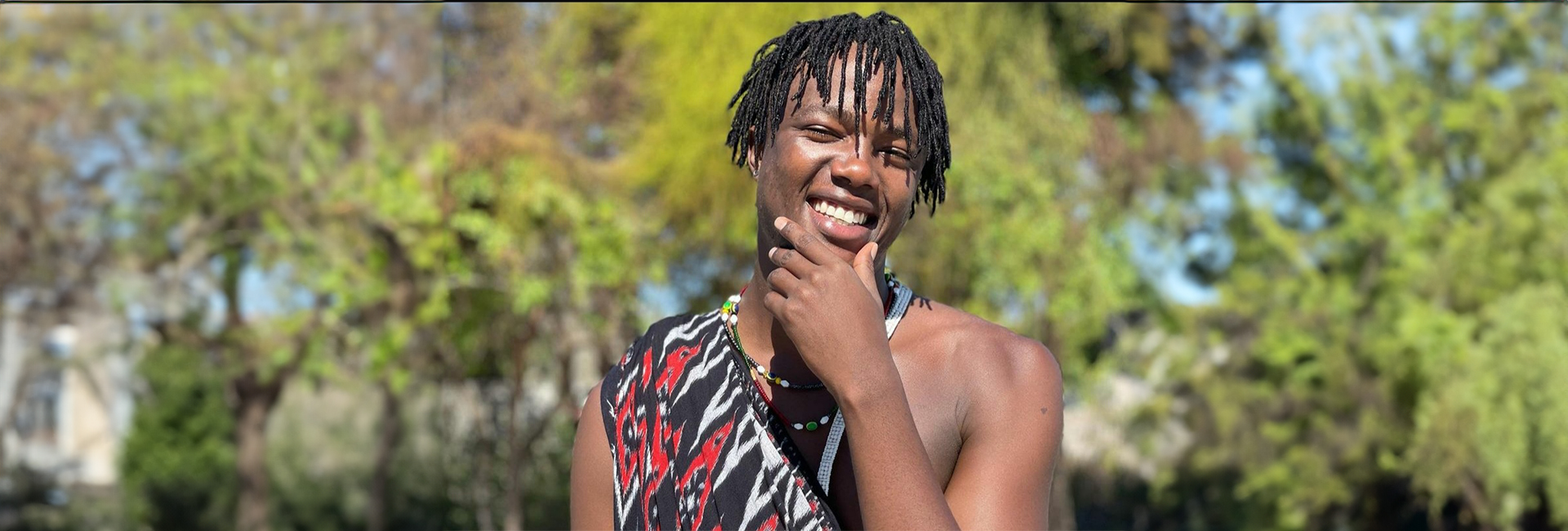(August 6, 2024) Sitting on a boat in a lake surrounded by water lilies in the picturesque landscape of Morogoro in Tanzania, social media star Kili Paul is lip-syncing to the popular song Suniya Suniya Raatan. His love for Indian music isn’t a secret as the 29-year-old’s social media is full of videos of him performing popular Bollywood songs. Clad in his Masaai attire, he never misses a chance to show his love for Bollywood. So much so that he was honoured by Indian High Commission in Tanzania for promoting Indian music and culture. But he isn’t the only one, hundreds of heartwarming videos of Africans immaculately singing Bollywood numbers are proof that our films have touched millions of hearts in the continent of Africa, even some 6,000 kilometers away.
View this post on Instagram
Bollywood first made its mark in Africa in the 1950s. With Hollywood film licensing hefty on their pockets, Africans found a perfect alternative in Bollywood films. The themes, plots, and lively song and dance routines of Bollywood films resonated with African audiences. Even without dubbing, Hindi films drew packed houses across the continent.
The love affair that began some 70 years ago is growing stronger with each passing day. From the shores of Tanzania to the inlands of Mali, every country in the continent shares a strong bond with Bollywood.
Arun Ashokan, who moved to Malawi five years ago, vouches for Africans’ love for Bollywood. “I recently spotted this girl in Mponela singing a Hindi film song, who came running to me inquiring about the film. They love Bollywood films, and music and even watch Hindi serials. They have small theatres in villages where they play these movies and serials,” he tells Global Indian.
Mali’s Bollywood-themed radio shows
Bollywood has even enchanted the people of Bamako in Mali. Nestled on the banks of the calm Niger river, Bamako boasts of rich history, diverse linguistic and cultural traditions. But this West African country’s love for Bollywood is an open secret. Even the 8,604 km distance between Mumbai and Bamako is no spoiler for Malians who love Bollywood and Indian culture.
Anjani Kumar, Ambassador of India to the Republic of Mali told Financial Express that there is a significant fan base for Bollywood cinema, song, and dance in Mali. He described his meeting with singer Mofas Khan as truly enriching. “An ardent Indophile who has never been to India but his love for our country and culture is admirable. He is a passionate singer who has learnt Hindi without a teacher. He presents a weekly radio program called India Gaana dedicated to Bollywood where he painstakingly interprets Hindi songs in Bambara, the lingua franca of Mali and West Africa, and also gives information about the film personalities.”
Hailing from a village in Mopti, Mofas Khan expresses his love for India through Bollywood songs. Like many Bamako residents, Khan, too, grew up on a rich diet of Bollywood films and has been in love with the Indian culture ever since. It was Rote Rote Hasna Seekho from Andha Kanoon that Khan crooned for the first time, and since then, there has been no looking back for this Indophile.
But Khan is not the only known Bollywood aficionado in Mali. Seydou Dembele is another resident of the country who wears his love for Bollywood up his sleeve. A school teacher by profession, Dembele was introduced to Hindi cinema by his father who worked at a theatre that screened Bollywood films. For the last 25 years, he has been presenting a radio show – Indian Frequency on Bollywood Songs – every Sunday afternoon.
Such has been his popularity that even Prime Minister Narendra Modi mentioned him during Mann Ki Baat in 2020. “His passion for India, affection, and love are indeed a matter of pride for us,” the PM had said.
When Seduji visited #Kumbh and at that time he was part of the delegation that I met, his passion for India, affection and love are indeed a matter of pride for all of us: PM @narendramodi #MannKiBaat #PMonAIR pic.twitter.com/RC2HtjBBQQ
— All India Radio News (@airnewsalerts) September 27, 2020
The love for Bollywood music extends beyond radio shows, flourishing in cultural groups that promote Indian music and dance. Three prominent cultural groups in the capital, Bamako—Yaarana Hindustani, Bollywood Fans International, and Dostiare—periodically organize cultural events. These events bring together Malian artists, singers, and dancers who have dedicated themselves to various aspects of Indian culture.
Ghana’s romance with Bollywood classics
Some 1,100 kilometers away, Rex Cinema in Ghana’s Kumasi had become a favourite with Bollywood fans during the 1960s. The theatre played Bhagwan Dada and Geeta Bali’s Albela every Friday for a year, selling out its 2,000-seat capacity.
It was the post-colonial period that brought Bollywood films to the shores of Ghana. The recurrent themes of community, honour, morality, and family values resonated with the people of Ghana, kindling their love for Bollywood.
In the capital city of Tamale, old Hindi films like Albela (1951), Love In Tokyo (1966), Noorie (1979), and Andha Kanoon (1983) are still viewed by residents in their homes and neighbourhood video centers. The people of Ghana devour Hindi films, and their love for Bollywood can be seen across innumerable DVD shops.
While the Bollywood classics are a hit with Ghanaians, the older Dagomba (ethnic group of Ghana)viewers outright rejected the Bollywood films of the 90s citing cultural and moral shifts. The video center owners decided not to screen new Bollywood films.
Kannywood’s emergence in Nigeria, courtesy Bollywood
Nigeria’s love affair with Bollywood began in the 1950s. Considered to be a cheaper alternative to the latest Hollywood hits, some Lebanese merchants decided to import Hindi films to Nigeria. Soon attending Bollywood film screenings in open courtyards became commonplace in Nigerian culture. Interestingly, the films screened were neither dubbed nor subtitled in the native language. Mainly because the Nigerian communities saw themselves in the stories portrayed in Hindi cinema, Bollywood was able to cut through the language barrier in Africa.
Be it pulp fiction or devotional songs, Bollywood left an indelible mark on Hausa culture – it acted as a catalyst in the creation of Kannywood, the north Nigerian movie hub based out of Kano. Kannywood Studios often replicate Bollywood movies shot by shot, and they also produce music videos heavily influenced by Indian styles. In 2013, an album inspired by this trend was released in Nigeria, titled Harafinso: Bollywood-Inspired Film Music from Hausa Nigeria.
Even the women of Nigeria have found inspiration in Bollywood which led to the emergence of soyayya – or – love literature in the 80s. The Hausa women, deeply inspired by the innocent romance in Hindi films, started writing soyayya novels to modernise their conservative communities.
Over the years, Bollywood’s grip on Nigeria has become as strong as ever, and now Nollywood (the Nigerian film industry) is collaborating with Bollywood to produce films together. The 2020 Netflix film Namaste Wahala, based on a romantic relationship between an Indian boy and a Nigerian girl, is the perfect example of this collaboration. S Pratibha, who moved with her husband to Abuja two years ago, says that Nigerians grew up on a staple of Bollywood films. “They love everything Bollywood. On the streets, you often find Bollywood music playing. It is a great feeling to see Nigerians embracing Hindi music.”
Kenya’s pop culture boost from Bollywood
In Nigeria, Bollywood served as a source of inspiration, while in Kenya, Hindi films significantly influenced music genres, landscapes, and fashion, offering dreams during the 60s, 70s, and 80s. With a huge population of Asians residing in Kenya from the 60s to the 90s, Bollywood became an integral part of the culture. Globe Cinema in Nairobi was the go-to destination for Bollywood film buffs and the movies it showcased opened doors to Indian culture among East Africa’s Asian community. The film provided a quick lesson in fashion customs and traditions.
From Rajesh Khanna to Shah Rukh Khan, Bollywood stars have left an imprint on the people of Kenya. In 2019, actor Anupam Kher shared a video of a Kenyan couple lip-syncing to Tujhe Dekha Toh Yeh Jaana Sanam from Dilwale Dulhaniya Le Jayenge. The same year, the first-ever Indian Films Festival was held in Kenya.
Presenting #Sharukh and #Kajol from Kenya lip-synching the eternal love song from the eternal #dilwaledulhanialejayenge. Video shared by the man who composed the song, @pandit_lalit. Enjoy.🤓🙏😎😍 #MusicIsUniversal pic.twitter.com/5gwga3kARv
— Anupam Kher (@AnupamPKher) September 12, 2019
Like music, films transcend boundaries, and this is especially true for Bollywood films. If you’re an Indian traveler, chances are you’ve encountered people who recognize your identity because of Bollywood stars. That’s the power of Hindi cinema. Over the last 60 years, Africans have embraced Bollywood films to the extent that they have become a part of their culture. Indian films have left an indelible mark on Africa, and this love affair continues to grow for both regions. However, the challenge remains that many African countries still prefer classic films from the past. The task now is to make contemporary Indian cinema more appealing to a global audience.
Read a similar story – 70 Years of Indian Cinema in Russia




